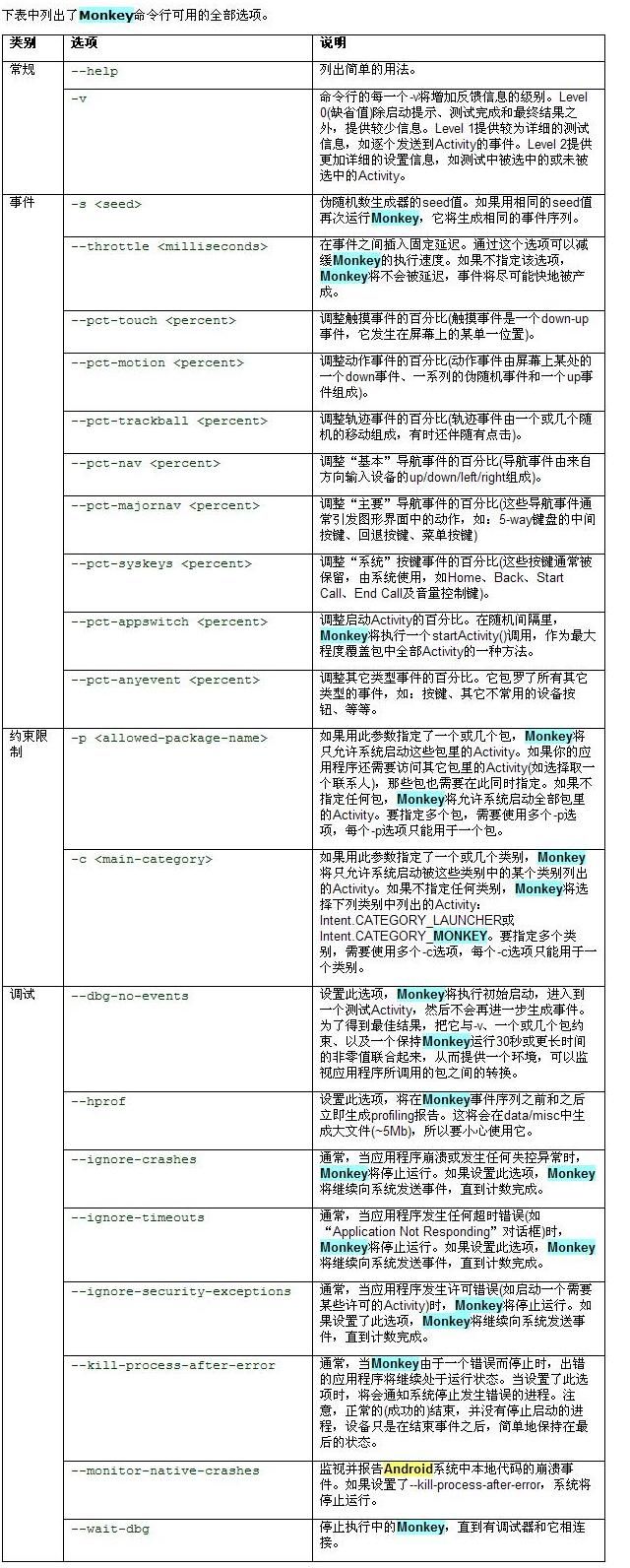Android之monkey测试!
Monkey是在模拟器上或设备上运行的一个小程序,它能够产生为随机的用户事件流,例如点击(click),触摸(touch),挥手(gestures),还有一系列的系统级事件。你可以使用Monkey来给你正在开发的程序做随机的,但可重复的压力测试 。
The Monkey is a command-line tool that that you can run on any emulator instance or on a device. It sends a pseudo-random stream of user events into the system, which acts as a stress test on the application software you are developing.
The Monkey includes a number of options, but they break down into four primary categories:
When the Monkey runs, it generates events and sends them to the system. It also watches the system under test and looks for three conditions, which it treats specially:
Depending on the verbosity level you have selected, you will also see reports on the progress of the Monkey and the events being generated.
You can launch the Monkey using a command line on your development machine or from a script. Because the Monkey runs in the emulator/device environment, you must launch it from a shell in that environment. You can do this by prefacing adb shell to each command, or by entering the shell and entering Monkey commands directly.
The basic syntax is:
With no options specified, the Monkey will launch in a quiet (non-verbose) mode, and will send events to any (and all) packages installed on your target. Here is a more typical command line, which will launch your application and send 500 pseudo-random events to it:
|
Monkey是运行在模拟器或设备上的一个程序,用来伪随机地模拟点击和触摸等用户事件,就如其它许多系统事件一样。Monkey可以用于对我们开发的应用程序进行随机和重复的压力测试。 简介 Monkey是一个命令行工具,可以运行在模拟器里或实际设备中。它向系统发送伪随机的用户事件流,实现对正在开发的应用程序进行压力测试。Monkey包括许多选项,它们大致分为四大类: · 基本配置选项,如设置尝试的事件数量。 · 运行约束选项,如设置只对单独的一个包进行测试。 · 事件类型和频率。 · 调试选项。 在Monkey运行的时候,它生成事件,并把它们发给系统。同时,Monkey还对测试中的系统进行监测,对下列三种情况进行特殊处理: · 如果限定了Monkey运行在一个或几个特定的包上,那么它会监测试图转到其它包的操作,并对其进行阻止。 · 如果应用程序崩溃或接收到任何失控异常,Monkey将停止并报错。 · 如果应用程序产生了应用程序不响应(application not responding)的错误,Monkey将会停止并报错。 按照选定的不同级别的反馈信息,在Monkey中还可以看到其执行过程报告和生成的事件。 Monkey基本用法 可以通过开发机器上的命令行或脚本来启动Monkey。由于Monkey运行在模拟器/设备环境中,所以必须用其环境中的shell来进行启动。可以通过在每条命令前加上adb shell来达到目的,也可以进入Shell后直接输入Monkey命令。基本语法如下: $ adb shell monkey [options] 如果不指定options,Monkey将以无反馈模式启动,并把事件任意发送到安装在目标环境中的全部包。下面是一个更为典型的命令行示例,它启动指定的应用程序,并向其发送500个伪随机事件: $ adb shell monkey -p your.package.name -v 500 命令选项参考
|
